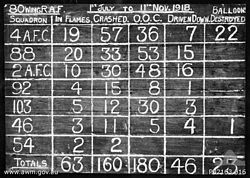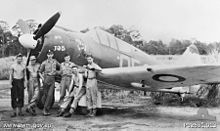- No. 4 Squadron RAAF
-
 Serny, France, November 1918. A score board recording the claims for enemy aircraft destroyed by No. 80 Wing RAF from July–November 1918. The squadrons listed are: No. 4 Squadron AFC, No. 88 Squadron RAF, No. 2 Squadron AFC, No. 92 Squadron RAF, No. 103 Squadron RAF, No. 46 Squadron RAF, and No. 54 Squadron RAF. The other columns are headed "In Flames", "Crashed", "O.O.C." (Out of Control), "Driven Down" and "Balloons Destroyed"."
Serny, France, November 1918. A score board recording the claims for enemy aircraft destroyed by No. 80 Wing RAF from July–November 1918. The squadrons listed are: No. 4 Squadron AFC, No. 88 Squadron RAF, No. 2 Squadron AFC, No. 92 Squadron RAF, No. 103 Squadron RAF, No. 46 Squadron RAF, and No. 54 Squadron RAF. The other columns are headed "In Flames", "Crashed", "O.O.C." (Out of Control), "Driven Down" and "Balloons Destroyed"."
No. 4 Squadron is a Royal Australian Air Force squadron responsible for training forward air controllers. The squadron was previously a fighter and army co-operation unit active in both World War I and World War II.
Contents
History
World War I
No. 4 Squadron was established as a unit of the Australian Flying Corps (AFC) at RAAF Point Cook on 16 October 1916. Shortly after its formation the squadron departed for Britain, arriving at Castle Bromwich for further training in March 1917.
The unit arrived in France on 18 December 1917. During its time on the Western Front, it performed fighter sweeps, provided air support for the Army, and raided German airstrips. No. 4 Squadron claimed more 'kills' than any other AFC unit: 199 enemy aircraft destroyed.[1] 11 of its pilots became aces. Notable members of the unit included Captain Harry Cobby, the AFC's leading ace of the war, credited with destroying 29 aircraft and observation balloons, and Captain George Jones, who shot down 7 aircraft and later served as the RAAF's Chief of the Air Staff for 10 years.[1] Besides Cobby and Jones, aces Elwyn King, Edgar McCloughry, Herbert Watson, Thomas Baker, Leonard Taplin, Thomas Barkell, Norman Trescowthick, and Garnet Malley also served in the squadron.[2]
Following the Armistice, No. 4 Squadron remained in Europe and, as part of the British Army of Occupation, was based in Cologne. It returned home in March 1919 and was disbanded in Melbourne in June.
World War II
No. 4 Squadron was re-formed as a general reconnaissance unit at RAAF Station Richmond, New South Wales, on 3 May 1937, flying Hawker Demons before taking delivery of its first Avro Anson the following month. Re-numbered No. 6 (General Reconnaissance) Squadron on 1 March 1939, No. 4 Squadron was re-formed again at Richmond on 17 June 1940, this time as an army co-operation unit. Originally equipped with Demons and De Havilland Moths, it converted to CAC Wirraways in September and relocated to Canberra later that month.[3] On 20 May 1942, No. 4 Squadron deployed to Camden Airfield, where it flew anti-submarine patrols as well as army co-operation training sorties until redeploying to Queensland and then in November to New Guinea.
The squadron's initial task in New Guinea was to support the American and Australian forces in the Battle of Buna-Gona. Until the end of the war the Squadron operated in the army co-operation role, providing ground forces with artillery observation, reconnaissance and close air support. On 26 December 1942, a No. 4 Squadron Wirraway piloted by Pilot Officer J. Archer shot down an A6M Zero. This was the only kill achieved by a Wirraway during the war and earned Archer the US Silver Star. On 31 January 1943, the squadron sent one of its flights to Wau, where it participated in the Battle of Wau.
In May 1943, No. 4 Squadron was re-equipped with CAC Boomerang fighter aircraft, to be operated in a tactical reconnaissance role. Operating with both these new aircraft and also some Wirraways retained, the Squadron supported the Australian 7th and 9th Divisions during the Huon Peninsula campaign. It also operated some Piper Cubs as liaison aircraft during these campaigns. The squadron continued to support Australian, US Army and US Marine Corps units in New Guinea and New Britain until March 1945 when it deployed to Morotai and then to the island of Labuan to support Australian ground forces in the Borneo campaign. It supported the 9th Division's campaign in North Borneo and the 7th Division's landing at Balikpapan.
Post-war years
After the war, No. 4 Squadron returned to Australia on 14 November 1945 and was again based at Canberra. It re-equipped with late-model P-40 Kittyhawks, having received a few of these aircraft while in Borneo, and this was followed by P-51 Mustangs. On 7 March 1948, No. 4 Squadron ceased to exist, having been re-numbered No. 3 Squadron.
No. 4 Squadron was re-formed on 3 July 2009 at RAAF Base Williamtown to train forward air controllers.[4] The Forward Air Control Development Unit (which operated PC-9s) (FACDU) was merged into the new unit, along with the RAAF's special tactics project team.[5] This continued the FAC presence at Williamtown which had been maintained by FACDU and No. 4 Flight, which operated Winjeels out of Williamtown from 1970 to 1989.
The squadron provides forward air controllers to support Special Operations Command. Personnel trained by No. 4 Squadron will accompany special forces patrols in order to accurately direct air strikes.[6]
Aircraft operated
- Sopwith Camel (1917–1918)
- Sopwith Snipe (1918–1919)
- Hawker Demon (1937 and 1940)
- Avro Anson (1937–1939)
- de Havilland Moth Minor (1940–1941)
- CAC Wirraway (1940–1945)
- de Havilland Tiger Moth (1942–?) (not confirmed)
- CAC Boomerang (1943–1945)
- Piper Cub (1943–1944)
- Curtiss P-40 Kittyhawk (1945–1947)
- CAC Mustang (1947–1948)
- Auster AOP III (1947–1948)
- Pilatus PC-9 (2009– )
Notes
- ^ a b Stephens, The Royal Australian Air Force, pp.16–21
- ^ http://www.theaerodrome.com/services/gbritain/rfc/71.php Retrieved 18 February 2010.
- ^ Roylance, Air Base Richmond, pp.41–42, 124
- ^ "New Air Force Capability at Williamtown" (Press release). Department of Defence. 3 July 2009. http://www.defence.gov.au/media/DepartmentalTpl.cfm?CurrentId=9232. Retrieved 3 July 2009.
- ^ Special Tactics people wanted at Air Force News. Retrieved 20 March 2008.
- ^ Allard, Tom (2008-03-17). "New squadron will aim to cut civilian deaths". The Sydney Morning Herald. http://www.smh.com.au/news/national/new-squadron-will-aim-to-cut-civilian-deaths/2008/03/16/1205602195107.html. Retrieved 2008-09-19.
References
- RAAF Historical Section (1995). Units of the Royal Australian Air Force. A Concise History. Canberra: Australian Government Publishing Service.
- RAAF Museum No 4 Squadron
- Roylance, Derek (1991). Air Base Richmond. RAAF Base Richmond: Royal Australian Air Force. ISBN 0-646-05212-8.
- Stephens, Alan (2006) [2001]. The Royal Australian Air Force: A History. London: Oxford University Press. ISBN 0-19-555541-4.
- McLaughlin, Andrew (2009). "4SQN. A new era for JTAC training". Australian Aviation (Canberra: Phantom Media) (265). ISSN 08130876.
Main series 1 · 2 · 3 · 4 · 5 · 6 · 7 · 8 · 9 · 10 · 11 · 12 · 13 · 14 · 15 · 20 · 21 · 22 · 23 · 24 · 25 · 26 · 27 · 28 · 29 · 30 · 31 · 32 · 33 · 34 · 35 · 36 · 37 · 38 · 40 · 41 · 42 · 43 · 60 · 66 · 67 · 71 · 73 · 75 · 76 · 77 · 78 · 79 · 80 · 82 · 83 · 84 · 85 · 86 · 87 · 92 · 93 · 94 · 99 · 100 · 102 · 107 · 292 · Fighter · Rescue and Communication · Seaplane · Berlin Air Lift
Article XV squadrons Joint Netherlands-Australian squadrons Categories:- RAAF squadrons
- Military units and formations established in 1916
- 1916 establishments in Australia
Wikimedia Foundation. 2010.

